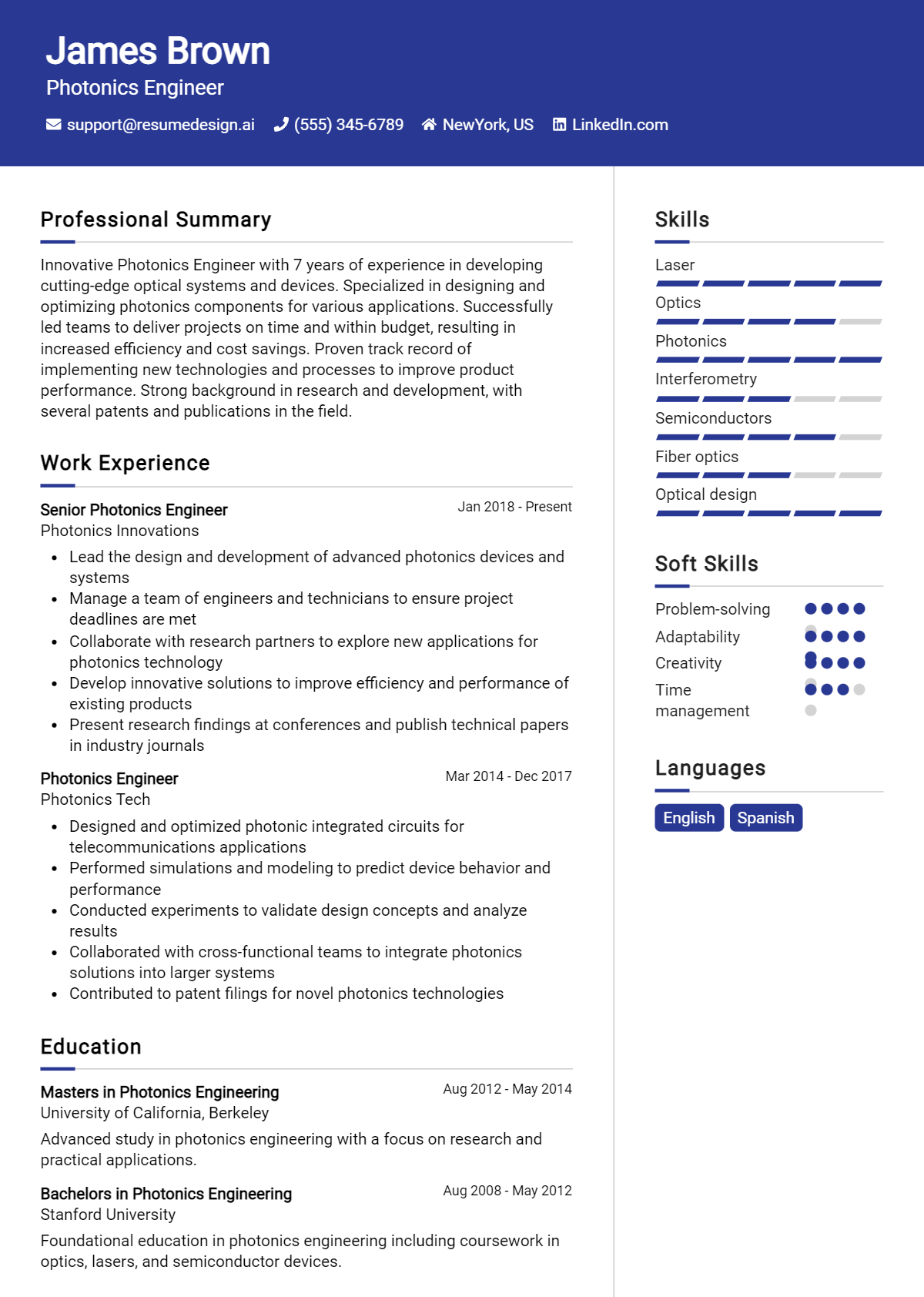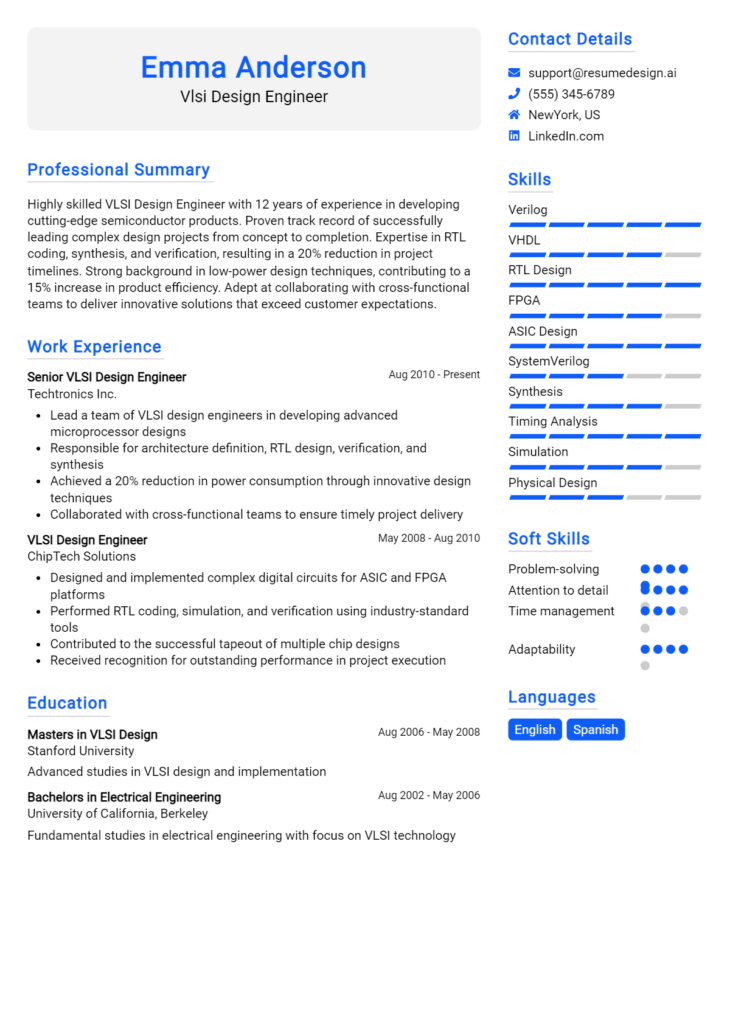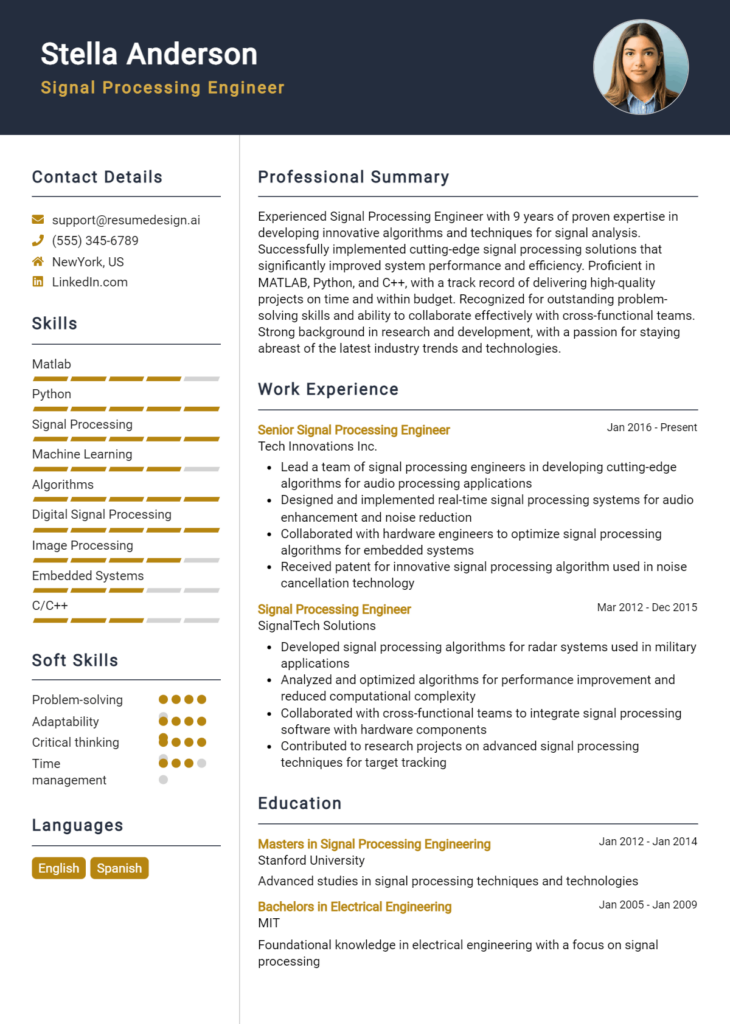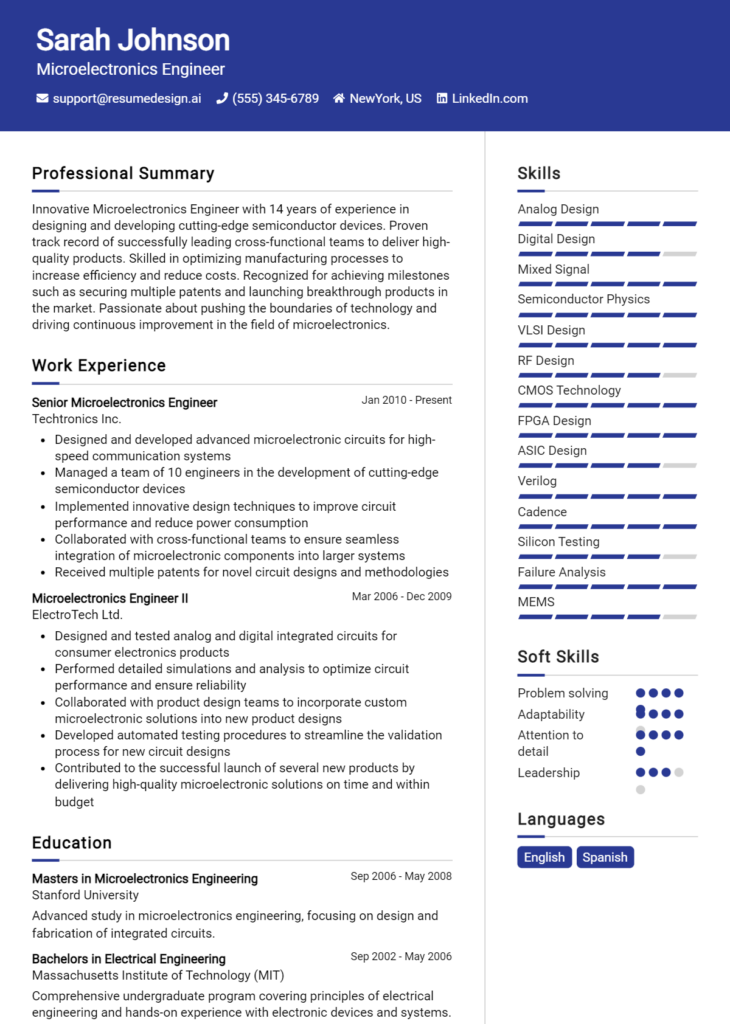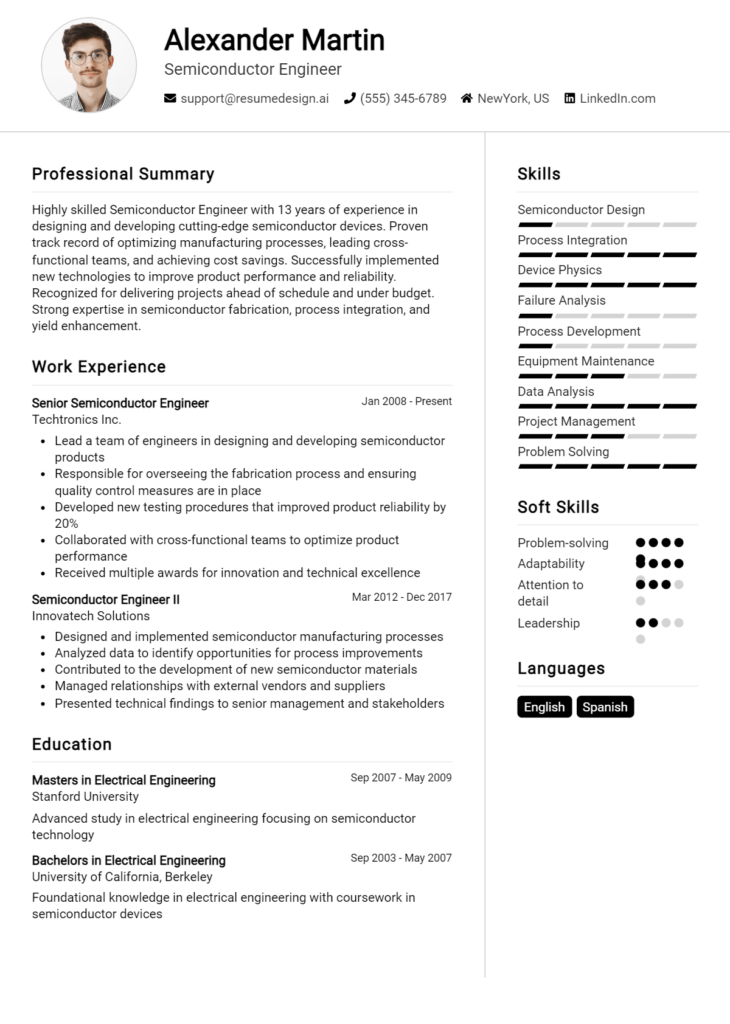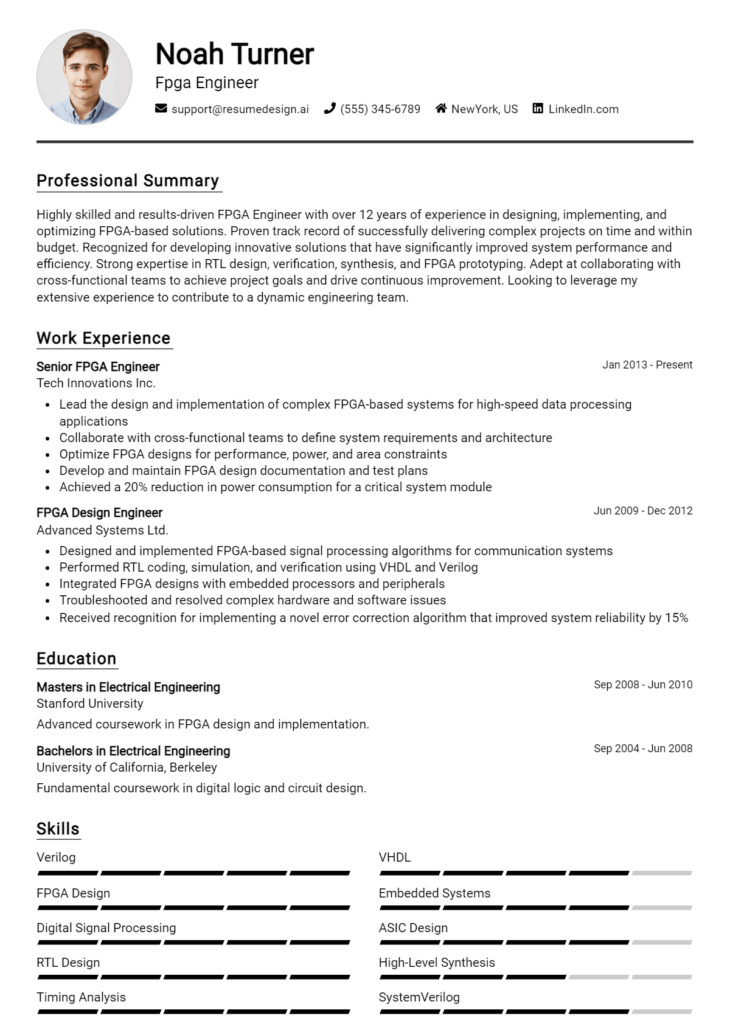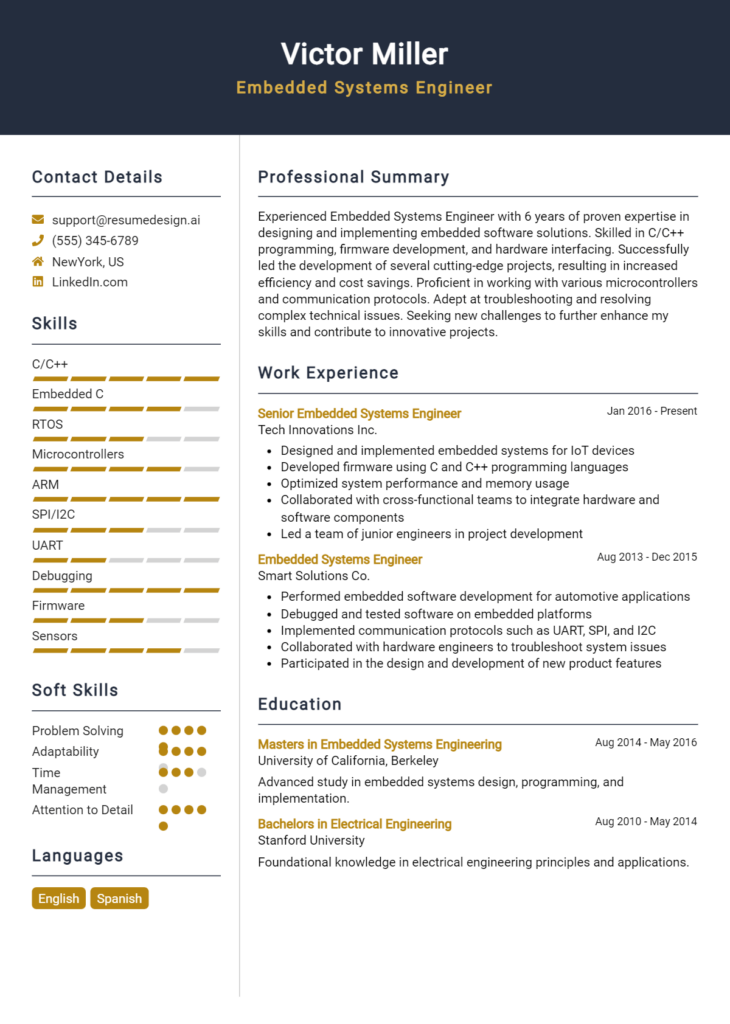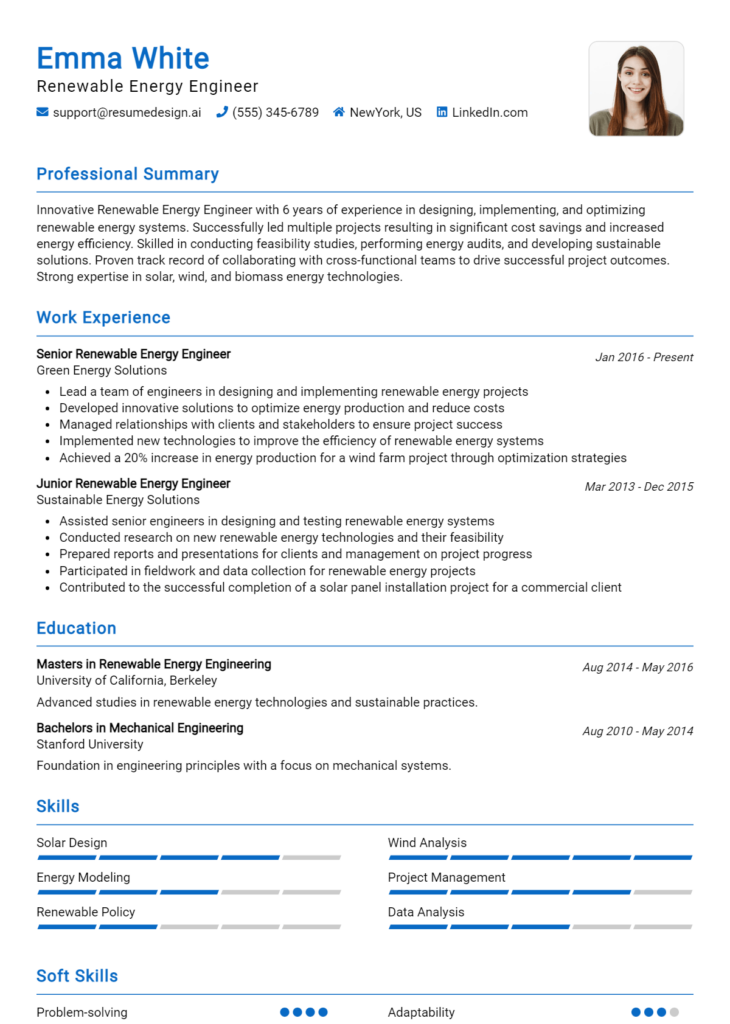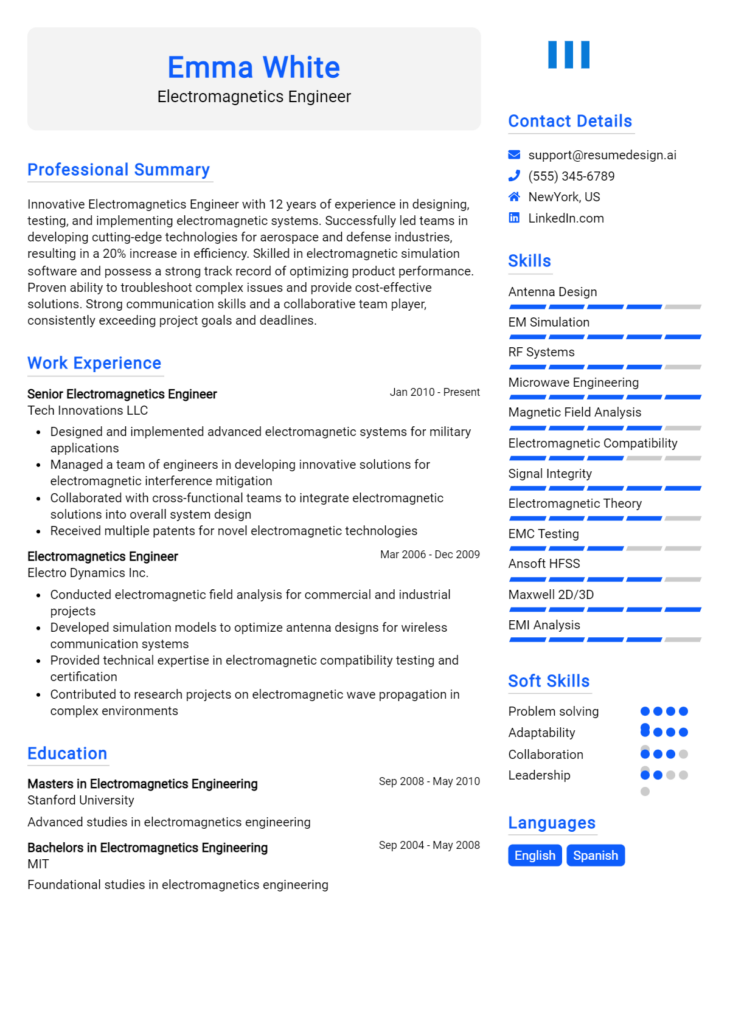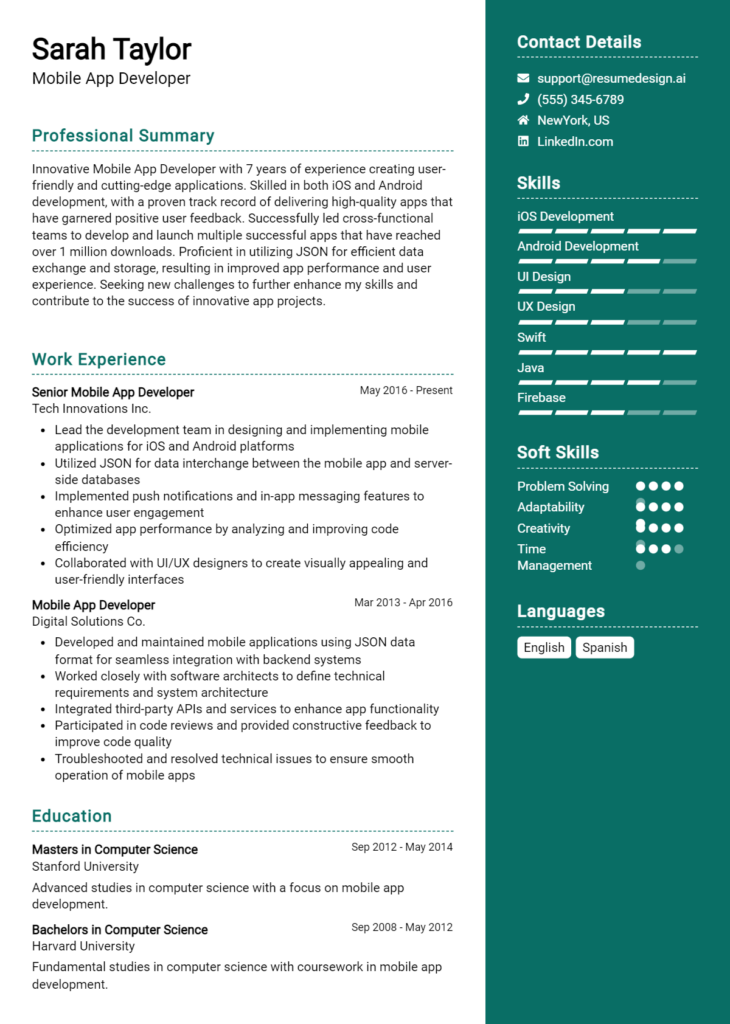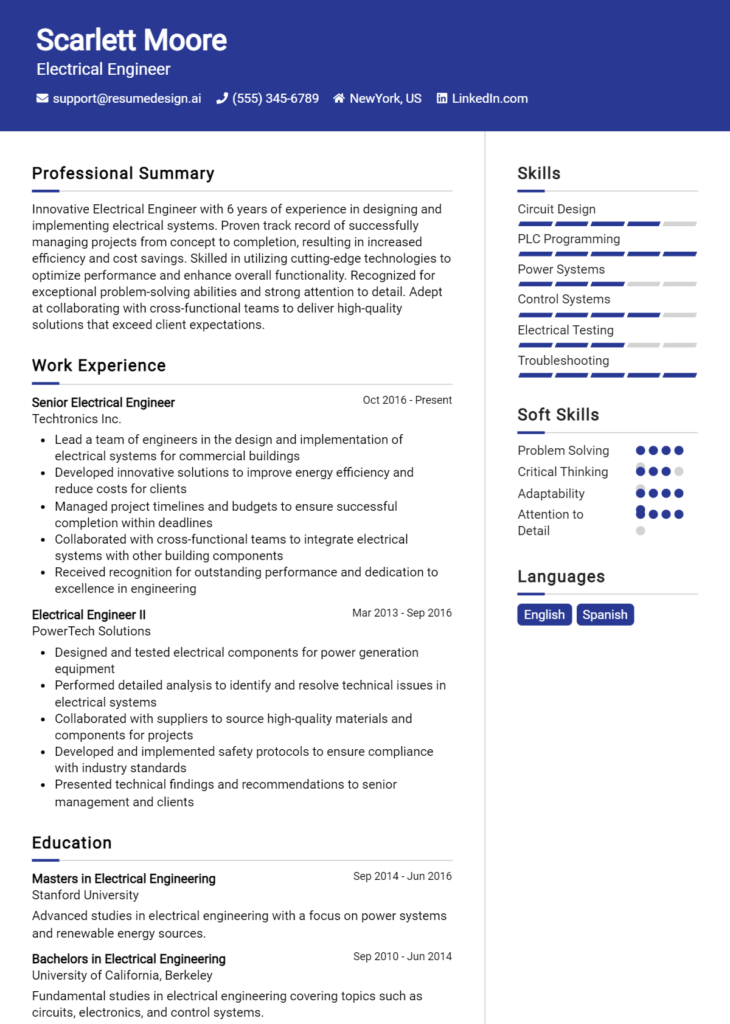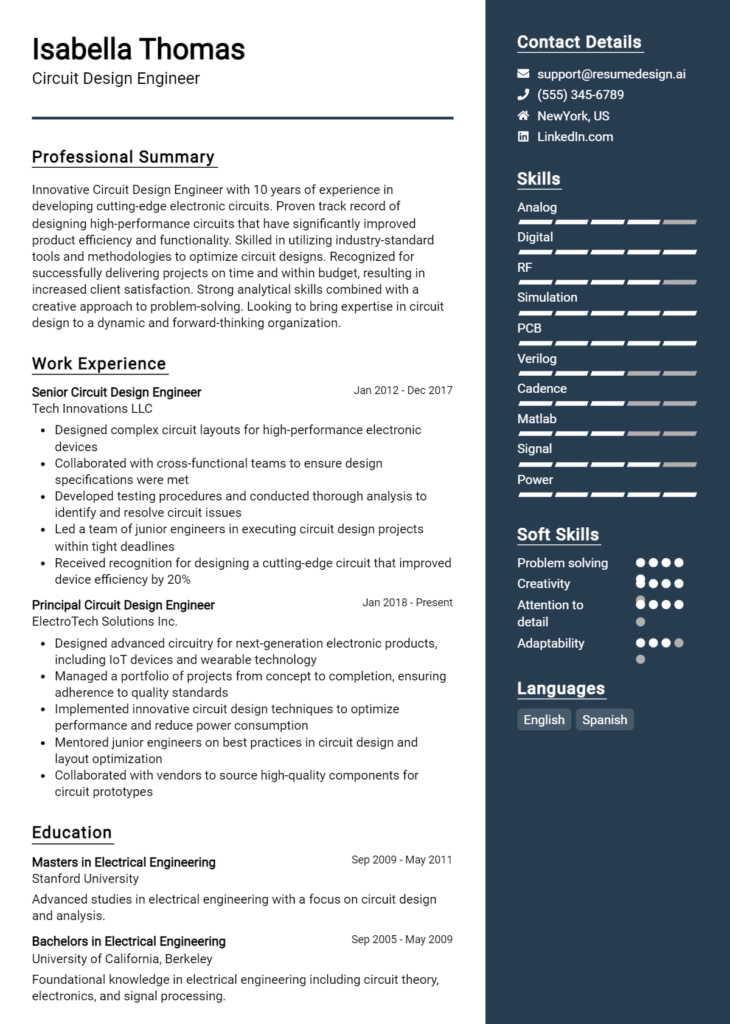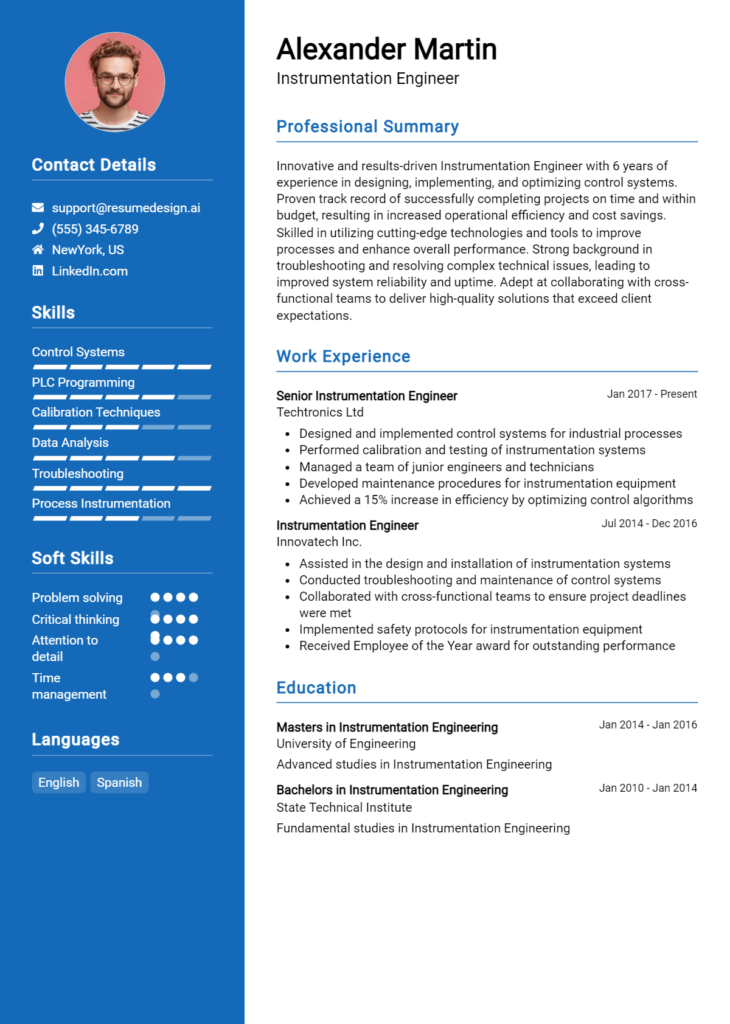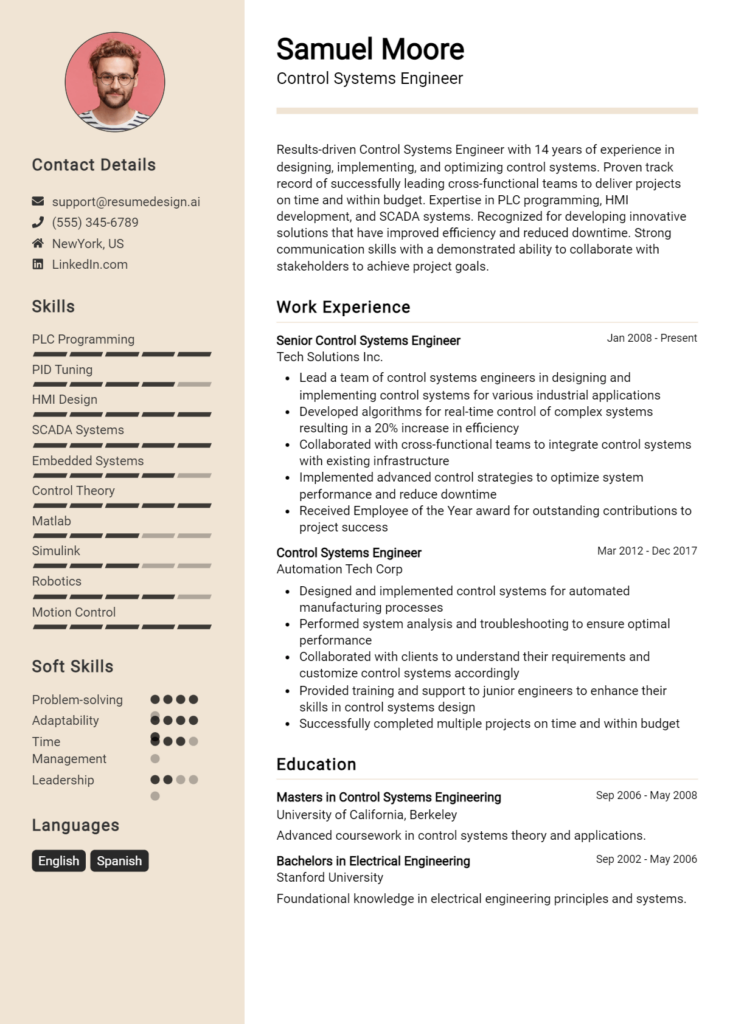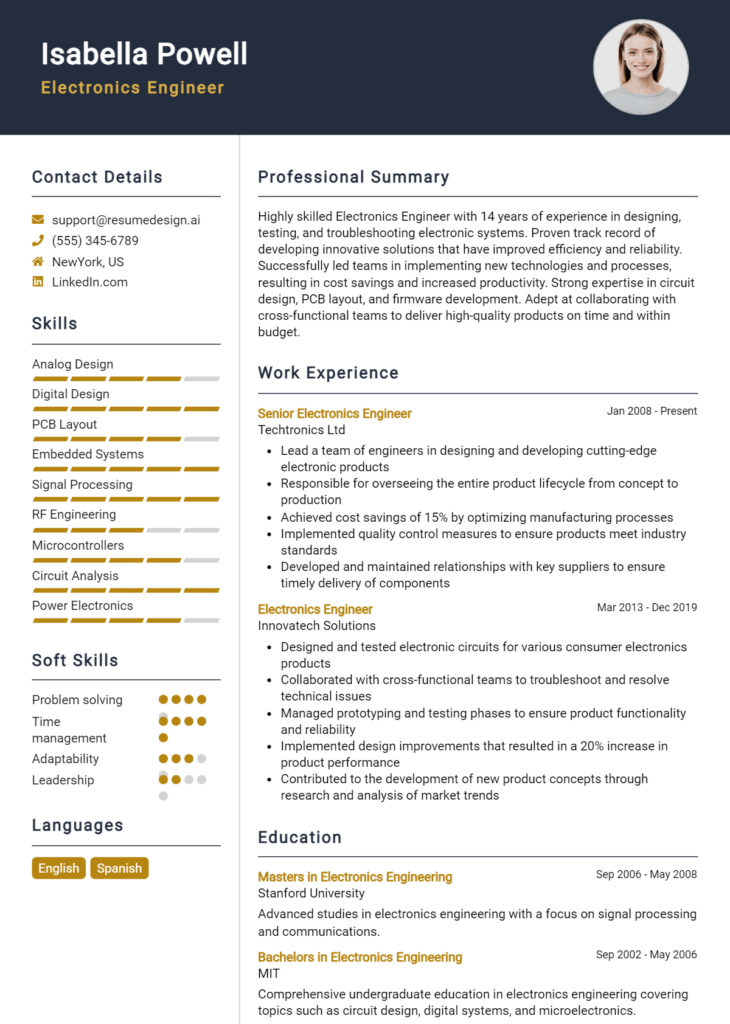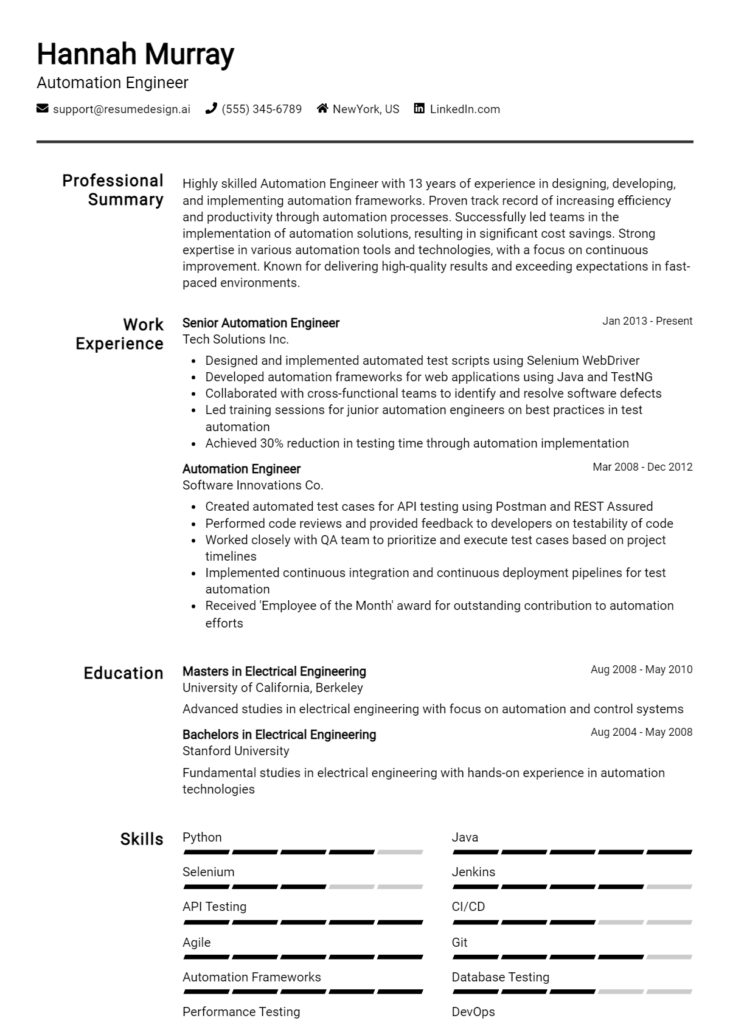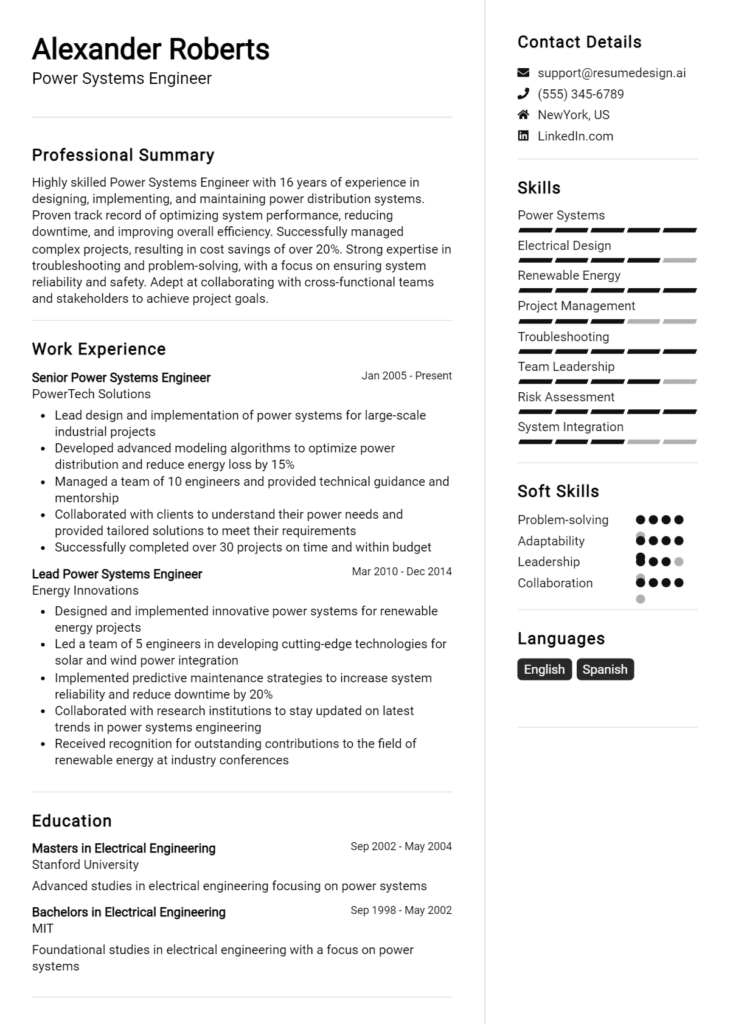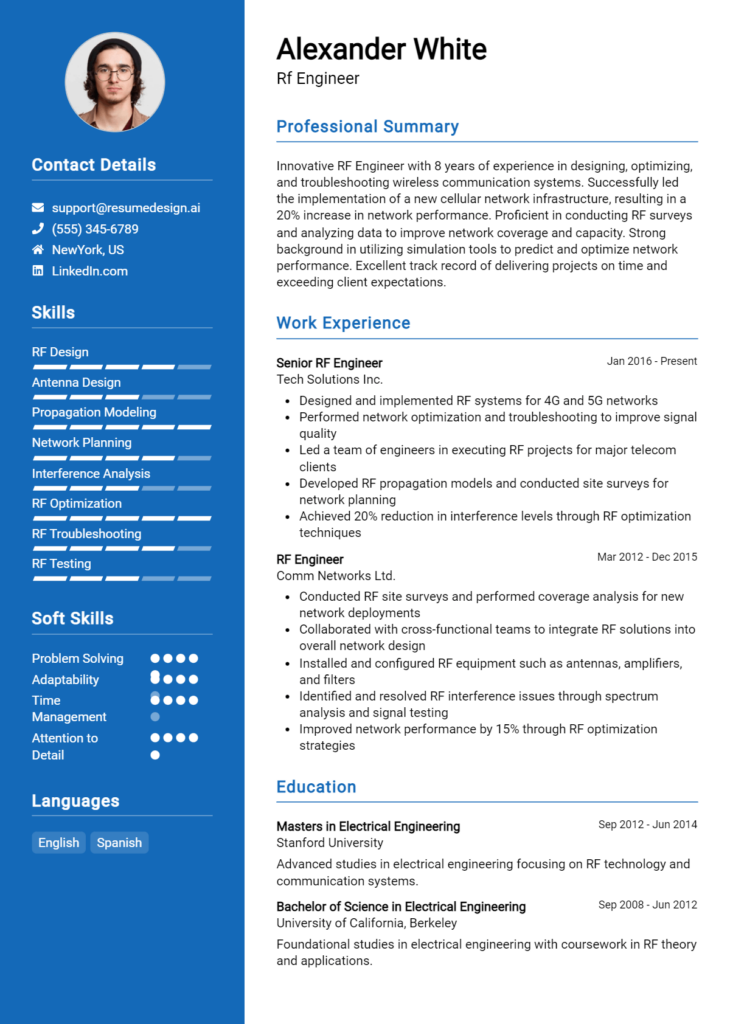Photonics Engineer Core Responsibilities
A Photonics Engineer plays a pivotal role in designing and developing technologies that utilize light, bridging various departments such as research, development, and manufacturing. Key responsibilities include conducting experiments, developing optical systems, and collaborating with cross-functional teams to solve complex problems. Essential skills encompass technical expertise in optics, operational efficiency, and strong analytical abilities. These competencies not only enhance project outcomes but also significantly contribute to the organization’s overarching goals. A well-structured resume can effectively highlight these qualifications, showcasing the engineer's impact and expertise.
Common Responsibilities Listed on Photonics Engineer Resume
- Design and develop optical components and systems.
- Conduct experiments and analyze data to optimize performance.
- Collaborate with interdisciplinary teams for integrated solutions.
- Develop and test prototypes for new photonic devices.
- Implement quality assurance protocols for optical products.
- Research advancements in photonics technology.
- Provide technical support and troubleshooting for optical systems.
- Document findings and present results to stakeholders.
- Ensure compliance with industry standards and regulations.
- Manage project timelines and deliverables effectively.
- Train and mentor junior engineers and technicians.
High-Level Resume Tips for Photonics Engineer Professionals
In the competitive field of photonics engineering, a well-crafted resume serves as your gateway to potential job opportunities. It is often the first impression you make on employers, and it needs to effectively showcase your skills, achievements, and unique contributions to the industry. A resume that is thoughtfully tailored to highlight your qualifications can make a significant difference in catching the eye of hiring managers. This guide will provide practical and actionable resume tips specifically designed for photonics engineer professionals, helping you stand out in a crowded job market.
Top Resume Tips for Photonics Engineer Professionals
- Tailor your resume to the specific job description by including relevant keywords and phrases that match the requirements.
- Showcase your relevant experience in photonics projects, emphasizing your role, responsibilities, and the technologies used.
- Quantify your achievements whenever possible, using metrics to demonstrate the impact of your contributions (e.g., improved efficiency by 20%).
- Highlight industry-specific skills such as optical design, laser technology, and photonic devices to align with employer expectations.
- Include any certifications or specialized training in photonics or related fields to enhance your credibility.
- Utilize a clear and professional format to ensure your resume is easy to read and visually appealing to hiring managers.
- Incorporate a summary statement that succinctly captures your expertise and career goals, tailored to the photonics engineering field.
- List relevant software proficiencies, such as CAD tools and simulation software, that are commonly used in photonics engineering.
- Consider including a section on publications or presentations if you have contributed to academic or industry research in photonics.
By implementing these targeted tips, you can significantly increase your chances of landing a job in the photonics engineering field. A polished resume that effectively communicates your skills and accomplishments will not only capture the attention of hiring managers but also set you apart from other candidates vying for the same opportunities.
Why Resume Headlines & Titles are Important for Photonics Engineer
In the competitive field of photonics engineering, a well-crafted resume headline or title serves as an essential tool to capture the attention of hiring managers. A strong headline can immediately summarize a candidate's key qualifications, providing a snapshot of their expertise and experience in a single impactful phrase. This concise yet relevant statement not only highlights the applicant’s skills but also aligns directly with the job they are applying for, ensuring that their resume stands out among a sea of applicants. By effectively communicating their unique value proposition, candidates can make a powerful first impression that encourages hiring managers to delve deeper into their qualifications.
Best Practices for Crafting Resume Headlines for Photonics Engineer
- Keep it brief: Aim for one to two lines that summarize your expertise.
- Be specific: Use keywords relevant to photonics engineering to demonstrate your niche skills.
- Highlight achievements: Incorporate quantifiable accomplishments to showcase your impact.
- Use active language: Choose dynamic words that convey confidence and capability.
- Tailor to the job: Customize your headline for each application to reflect the job description.
- Avoid jargon: Use clear and accessible language to ensure clarity for all readers.
- Emphasize qualifications: Focus on your most relevant certifications or degrees.
- Showcase innovation: Mention any unique projects or research that sets you apart.
Example Resume Headlines for Photonics Engineer
Strong Resume Headlines
Innovative Photonics Engineer with 10+ Years of Experience in Laser Design and Optical Systems
Results-Driven Photonics Specialist: Proven Track Record in Developing Cutting-Edge Imaging Technologies
Photonics Engineer with Expertise in Fiber Optics and Advanced Sensor Development
Creative Problem Solver in Photonics Engineering: Successfully Led Multi-Disciplinary Projects to Completion
Weak Resume Headlines
Engineer Looking for Opportunities
Photonics Professional with Some Experience
Seeking a Job in Engineering
The strong headlines are effective because they are specific, relevant, and highlight the candidate's unique qualifications and experiences, making it easy for hiring managers to see the value they bring to the role. In contrast, the weak headlines lack detail and specificity, failing to convey the candidate's skills or achievements, which can lead to them being overlooked in a crowded applicant pool. Strong headlines create immediate interest and set a positive tone for the rest of the resume, while weak ones do little to engage the reader.
Writing an Exceptional Photonics Engineer Resume Summary
In the competitive field of photonics engineering, a well-crafted resume summary serves as a critical first impression that can propel candidates to the forefront of hiring managers' attention. This brief yet impactful introduction encapsulates key skills, relevant experience, and notable accomplishments in a manner that is both concise and tailored to the specific job being applied for. A strong resume summary not only highlights the candidate's qualifications but also aligns them with the needs of the employer, making it an essential component of a successful application.
Best Practices for Writing a Photonics Engineer Resume Summary
- Quantify Achievements: Use specific numbers to demonstrate your impact, such as project timelines, budgets managed, or efficiency improvements.
- Focus on Relevant Skills: Highlight the skills that are most pertinent to the job description, such as optical design, laser technology, or data analysis.
- Tailor for the Job Description: Customize your summary for each application to reflect the specific qualifications and responsibilities outlined in the job posting.
- Keep it Concise: Aim for 3-5 sentences that deliver maximum information without overwhelming the reader.
- Use Active Language: Employ strong, action-oriented verbs to convey your achievements and capabilities effectively.
- Highlight Industry Knowledge: Mention any relevant certifications, technologies, or methodologies that showcase your expertise in photonics engineering.
- Showcase Interdisciplinary Skills: If applicable, include skills from related fields, such as materials science or electrical engineering, to demonstrate a well-rounded background.
- Emphasize Problem-Solving Abilities: Illustrate instances where you've successfully addressed engineering challenges, showcasing your critical thinking and innovation.
Example Photonics Engineer Resume Summaries
Strong Resume Summaries
Results-driven Photonics Engineer with over 5 years of experience in optical design and fabrication. Successfully led a team to develop a high-efficiency laser system, resulting in a 30% increase in output power while reducing production costs by 15%.
Innovative Photonics Engineer skilled in advanced imaging systems and photonic integrated circuits. Achieved a 25% reduction in signal loss in optical fibers through the implementation of a novel coating technique, enhancing overall system performance.
Detail-oriented Photonics Engineer with a proven track record in project management and cross-functional collaboration. Spearheaded a project that developed a new photonic sensor technology, which improved detection capabilities by 40%, leading to significant client satisfaction.
Weak Resume Summaries
Dedicated engineer with experience in photonics. Looking for a new opportunity in a challenging environment.
Photonics professional with various skills and knowledge. I have worked on many projects and am eager to contribute to a team.
The provided examples illustrate the distinction between strong and weak resume summaries. Strong summaries effectively quantify achievements, highlight specific skills relevant to photonics engineering, and demonstrate a clear alignment with industry requirements. In contrast, weak summaries lack detail and specificity, making them less impactful and engaging for hiring managers. A compelling summary should serve as a powerful introduction that sets the tone for the rest of the resume, drawing attention to the candidate's qualifications and potential contributions to the organization.
Work Experience Section for Photonics Engineer Resume
The work experience section of a Photonics Engineer resume is crucial as it serves as a platform to demonstrate the candidate's technical skills, leadership capabilities, and successful delivery of high-quality products. This section not only highlights the specific roles and responsibilities the candidate has undertaken but also showcases their ability to manage teams effectively and collaborate on complex projects. By quantifying achievements and aligning experiences with industry standards, candidates can present a compelling narrative that illustrates their value to potential employers, making this section a key component of a standout resume.
Best Practices for Photonics Engineer Work Experience
- Clearly articulate your technical skills related to photonics, such as optical design, laser systems, or materials science.
- Quantify your achievements with specific metrics, such as percentage improvements, cost reductions, or project timelines.
- Highlight leadership experiences, including team management, project leadership, or mentoring roles.
- Showcase collaboration with cross-functional teams, emphasizing communication and teamwork.
- Tailor your experiences to align with the job description and industry standards.
- Use action verbs and specific technical terminology relevant to the field of photonics.
- Include notable projects or innovations that demonstrate your problem-solving abilities.
- Avoid jargon and ensure clarity, making it easy for hiring managers to understand your contributions.
Example Work Experiences for Photonics Engineer
Strong Experiences
- Led a team of engineers in the development of a new laser system, resulting in a 30% increase in efficiency and a 15% reduction in production costs.
- Managed a cross-functional project that successfully launched a photonic sensor, achieving a market entry three months ahead of schedule.
- Designed and implemented an optical system that improved signal clarity by 25%, enhancing product performance and customer satisfaction.
- Collaborated with research teams to develop innovative materials for photonic applications, leading to two published papers in peer-reviewed journals.
Weak Experiences
- Worked on various projects related to photonics without specific details on contributions or outcomes.
- Assisted in the design of optical systems; however, did not specify the impact or success of the designs.
- Participated in team meetings and discussions but lacked concrete examples of leadership or initiative.
- Involved in research with no clear description of the projects or results achieved.
The examples of strong experiences are considered effective because they provide clear, quantifiable outcomes that demonstrate the candidate's impact on projects, as well as their leadership and collaborative skills. In contrast, the weak experiences lack specificity and measurable results, making it difficult for hiring managers to gauge the candidate's contributions or relevance to the role. Strong experiences articulate a narrative of success and capability, while weak experiences leave too much open to interpretation.
Education and Certifications Section for Photonics Engineer Resume
The education and certifications section of a Photonics Engineer resume is crucial for showcasing the candidate's academic credentials and professional development. This section not only highlights the foundational knowledge gained through formal education but also emphasizes the importance of industry-relevant certifications and specialized training. By listing relevant coursework, certifications, and ongoing learning efforts, candidates can significantly enhance their credibility and demonstrate their alignment with the specific requirements of the job role, ultimately increasing their attractiveness to potential employers.
Best Practices for Photonics Engineer Education and Certifications
- Prioritize relevant degrees such as a Bachelor's or Master's in Photonics, Optical Engineering, or related fields.
- Include industry-recognized certifications, such as those from the Optical Society (OSA) or the International Society for Optics and Photonics (SPIE).
- Detail specific coursework that aligns with job requirements, such as courses in laser technology, fiber optics, or quantum optics.
- Highlight any specialized training programs or workshops that demonstrate advanced skills or technologies.
- Use clear and concise language to describe educational experiences, avoiding overly technical jargon.
- Keep the information up-to-date, removing any outdated certifications or courses that no longer hold relevance.
- Consider including GPA or academic honors if they are particularly impressive or relevant.
- Organize the section in reverse chronological order, starting with the most recent accomplishments first.
Example Education and Certifications for Photonics Engineer
Strong Examples
- M.S. in Optical Engineering, University of California, Berkeley, 2021
- Certified Optical Technician (COT), Optical Society of America, 2022
- Relevant Coursework: Laser Systems Design, Fiber Optic Communications, Quantum Photonics
- Professional Development: Advanced Photonics Workshop, SPIE, 2023
Weak Examples
- B.A. in History, University of Texas, 2010
- Certification in Basic Photography, Local Community College, 2015
- Relevant Coursework: Introduction to Sociology
- Completed Online Course in Digital Marketing, 2022
The strong examples are considered effective because they directly relate to the field of photonics, showcasing relevant degrees, certifications, and specialized coursework that align with the role's requirements. Conversely, the weak examples highlight irrelevant educational qualifications, such as degrees and certifications that do not pertain to photonics, thus failing to demonstrate the candidate's expertise in the industry. This contrast emphasizes the importance of relevance and specificity in the education and certifications section.
Top Skills & Keywords for Photonics Engineer Resume
When crafting a resume as a Photonics Engineer, it is essential to highlight both hard and soft skills that showcase your expertise in the field. Employers are not just looking for technical knowledge, but also for candidates who can collaborate effectively, think critically, and adapt to evolving technologies. A well-rounded resume will demonstrate your proficiency in specific photonics-related tools and methodologies while also emphasizing your interpersonal and problem-solving abilities. By tailoring your resume with the right skills, you can differentiate yourself from the competition and make a lasting impression on potential employers.
Top Hard & Soft Skills for Photonics Engineer
Soft Skills
- Strong communication skills
- Teamwork and collaboration
- Problem-solving abilities
- Critical thinking
- Adaptability and flexibility
- Time management
- Attention to detail
- Creativity and innovation
- Project management
- Customer-focused mindset
Hard Skills
- Knowledge of optics and photonics principles
- Proficiency in CAD software
- Experience with optical design software (e.g., Zemax, Code V)
- Familiarity with laser systems and applications
- Understanding of fiber optics technology
- Proficiency in simulation tools (e.g., COMSOL, ANSYS)
- Experience with laboratory equipment and measurement techniques
- Knowledge of electronic circuits and systems
- Programming skills (e.g., MATLAB, Python)
- Familiarity with manufacturing processes related to photonics
By emphasizing both your hard and soft skills in your resume, you can effectively convey your qualifications and readiness to tackle the challenges faced in the field of photonics engineering. Additionally, showcasing relevant work experience will further solidify your candidacy for the role.
Stand Out with a Winning Photonics Engineer Cover Letter
Dear [Hiring Manager's Name],
I am writing to express my enthusiasm for the Photonics Engineer position at [Company Name], as advertised on [where you found the job listing]. With a strong academic background in optical engineering, coupled with hands-on experience in developing photonic systems, I am confident in my ability to contribute effectively to your team. My passion for advancing photonic technologies aligns perfectly with [Company Name]'s commitment to innovation, making this opportunity particularly exciting for me.
During my time at [Previous Company/University], I successfully led a project focused on the design and optimization of laser systems for communication applications. This role not only honed my technical skills in optical design software such as Zemax and COMSOL but also enhanced my ability to collaborate with multidisciplinary teams to troubleshoot complex issues. My experience with fiber optics and photonic devices has equipped me with a solid foundation in both theoretical principles and practical applications, enabling me to tackle challenges with a solutions-oriented mindset.
I am particularly drawn to [Company Name] because of its reputation for pioneering work in [specific technology or project related to the company]. I am eager to bring my expertise in photonic integration and my dedication to continuous learning to your innovative projects. I believe that my proactive approach and strong analytical skills will enable me to contribute to the development of cutting-edge solutions that meet the ever-evolving demands of the industry.
Thank you for considering my application. I look forward to the possibility of discussing how my background, skills, and enthusiasms align with the goals of [Company Name]. I am excited about the opportunity to contribute to your team and to help drive advancements in photonics technology.
Sincerely,
[Your Name]
[Your Contact Information]
Common Mistakes to Avoid in a Photonics Engineer Resume
When crafting a resume for a Photonics Engineer position, it's essential to present your skills and experiences effectively. Many candidates make common mistakes that can hinder their chances of standing out in a competitive job market. Avoiding these pitfalls can significantly enhance the clarity and impact of your resume. Here are some common mistakes to watch out for:
Lack of Tailoring: Failing to customize your resume for each job application can make it seem generic. Highlight relevant skills and experiences that align with the specific job description.
Using Jargon: Overloading your resume with technical jargon may confuse hiring managers who lack specialized knowledge. Aim for clarity and ensure that your accomplishments are understandable to a broader audience.
Ignoring Soft Skills: Photonics Engineering often requires teamwork and communication skills. Neglecting to showcase these soft skills can give an incomplete picture of your qualifications.
Neglecting Formatting: A cluttered or overly complex format can detract from your content. Use clear headings, bullet points, and consistent fonts to improve readability.
Not Quantifying Achievements: Failing to quantify your accomplishments can make it difficult to gauge your impact. Use metrics to demonstrate your contributions, such as project success rates or efficiency improvements.
Overloading with Irrelevant Information: Including unrelated experience or excessive detail about past roles can dilute the focus of your resume. Keep content relevant to the position you're applying for.
Omitting Key Projects: Neglecting to highlight significant projects, particularly those that showcase your expertise in photonics, can result in missed opportunities to impress potential employers.
Inconsistent Tenses: Using different verb tenses within your resume can create confusion. Maintain consistency by using past tense for previous roles and present tense for current positions.
Conclusion
As a Photonics Engineer, your expertise in the manipulation of light and its applications is crucial in various industries, including telecommunications, healthcare, and manufacturing. Throughout this article, we've explored the essential skills and qualifications required for this role, such as proficiency in optics, materials science, and advanced imaging techniques. We also highlighted the importance of hands-on experience with photonic devices and systems, as well as the necessity of staying updated with the latest technological advancements in the field.
Furthermore, we discussed the significance of effective communication skills, both in collaborating with multidisciplinary teams and in presenting complex concepts to non-technical stakeholders. Networking and continuous professional development are vital for career advancement, allowing you to connect with peers and industry leaders.
In conclusion, it is crucial to ensure that your resume effectively showcases your unique qualifications and experiences as a Photonics Engineer. Take the time to review and enhance your resume to stand out in today’s competitive job market. Utilize valuable resources available to you, including resume templates, a user-friendly resume builder, a variety of resume examples, and cover letter templates to create a tailored application that highlights your strengths. Start refining your resume today and take the next step in your career!

